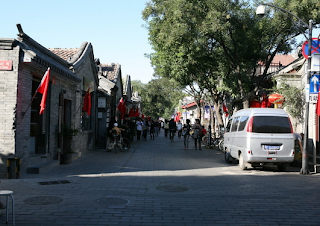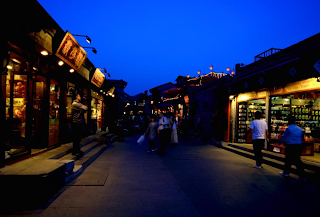In the last article, we have talked about the general situation of Beijing city. For better know this ancient city, today we will talk about the famous and unique Beijing architecture --Hutong.
Chapter Two
Beijing, Beijing? Old Beijing!
--Hutong culture of old Beijing
--Hutong culture of old Beijing
Hutong --old Beijing's timeless best
As it is known to all, in Chinese history, the Forbidden City is the symbol of China's royal family, then where can you experience the real life of common people in old Beijing? The answer must be the Hutongs--it's at the root of the old Beijing people's way of life.
Beijing City is like a boxy bean curd or a chess board with each hutong lying due north to due south or due east to due west. This sqare layout not only influences Beijinger's way of living, but also affects their thoughts and actions.
 |
| The Hutong in Beijing ( Houhai Hutong) |
● The Architecture Treasure of Hutong
Actually, the centuries-old, tree-lined alleyways of hutong are the true heartbeat of the unique city of old Beijing and a real-life link to its fascinating past. And these old hutongs are almost in the same form--old, walled courtyard homes are the building blocks of this delightful maze of lanes. More venerable abodes are fronted by thick red doors outside of which perch either a pair of lions or a pair of drum stones.
 |
| the Gong and Drum Lane (Nanluogu Xiang) |
Living conditions in the siheyuan are basic at best - a one-room family-house with a tiny shed-like kitchen-conversion and often no private toilet - but it’s this unusual mix of ancient aristocratic architecture and current-day, salt-of-the-earth locals that gives the hutong alleys their unique character.
● Old Hutong: the well-combined lifestyle
In old Beijing, People are pleased with their easy life in Siheyuan. They live a peaceful and harmonious life in these small "boxes", away from the hustle and bustle of the streets outside. Their daily needs could be fully satisfied by hawkers who sold vegetables, eggs, fruits, and snacks.
 |
| The Nightview of Siheyuan in Beijing |
From spring to autumn, men collect outside their gates, drinking beer, playing chess, smoking and chewing the fat. Inside, scholar trees soar aloft, providing shade and a nesting ground for birds. Flocks of pigeons whirl through the Beijing skies overhead, bred by locals and housed in coops often buried away within the hutong.
In the past, they could even get their hair cut by the itinerant barbers without walking out of their neighborhood to find a barber shop. The winding and narrow Hutongs were heaven for children playing games. They would have played rubber-band skipping, kicking shuttlecocks, and hide-and-seek.
Nowadays, while the rest of the city darts around in sharp suits, with a takeaway coffee in one hand and an iPhone in the other, old men sit on wooden stools at the entrance to their hundred-year-old hutong bungalows, drinking beer, playing chess and chewing the fat. The pace of life in these neighborhoods is less hurries than on Beijing's broad modern avenues. The noises less grating. The hutongs are like villages within the megalopolis.
What really need to mention out is that the charming and ragged lanes of hutong survives a warm sense of community and hospitality. --It's cozy pace of life is what modern people strongly eager for.
● Famous Hutongs, Strong Atmosphere of Old Beijing
The names of hutongs are all-embracing and various and relate to their location, origin or history, such as Lumicang, Fuxue, and Gongyuan hutongs, which were named by official organizations. Those examples named by craftsmen and ordinary people include: 'earthenware pot Liu (now Dashaguo) Hutong', maybe there once lived a Mr. Liu who sold earthenware pots.
Those who were named by their market trade include Xianyu Kou Hutong (Fish street), for it once was the place where fish was sold. Some Hutongs take their name from special landmarks, such as Stone Tiger, Iron Lion and Cypress hutongs.
the Gong and Drum Lane (Nanluogu Xiang)
It is an old lane renowned for its long history, culture, specialty stores, and distinctive foods. It is 768 meters (2,519 feet) long and 8 meters (26 feet) wide. Its north end joins East Drum Tower Avenue, and the south end is connected to East Di'anmen Avenue.
Dongjiaominxiang
 |
| Nightview of Skewed Tobacco Pouch Street |
Skewed Tobacco Pouch Street (Yandai Xiejie)
The skewed tobacco pouch street is one of the most famous in Beijing. It measures 254 yards long connecting Di'anmen Street at the east end and the junction of Xiaoshibei and Ya'er hutongs at the west end. Like a tobacco pouch, the street goes from north-east to south-west
These old and famous Hutongs carried Beijing´s history and traditional way of life. They have waited centuries´ of change in social and individual life. Today, they have become a platform of new culture and artistic innovation.
No comments:
Post a Comment
Thanks for your comment and welcome to China!